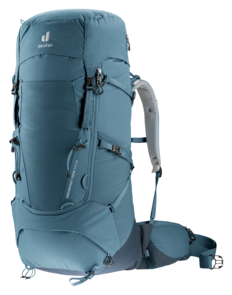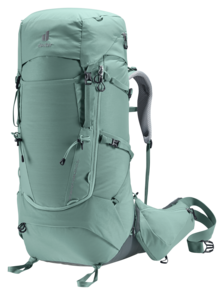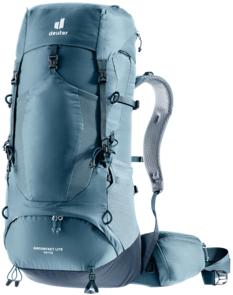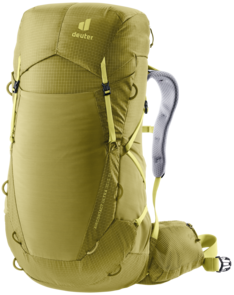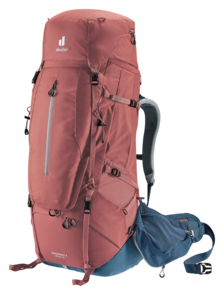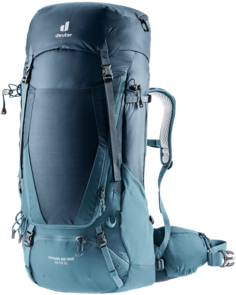Backpacking packs
- Avalanche backpacks
- Hiking backpacks
- Mountaineering backpacks
- Child carriers
- Ski tour backpacks
- Freeride backpacks
- Snowshoe backpacks
- Bike backpacks
- Trail running backpacks
- Protector backpacks
- Camera bags
- Backpacking backpacks
- Climbing backpacks
- Children’s backpacks
- School backpacks
- Lifestyle backpacks
- Travel backpacks
- back: Backpacks

thru-Hiking with gear that has your back: a deuter trekking backpack
Moving under your own steam. The crunch of dirt under your soles. And that sense of achievement as you reach your hiking destination late in the day. The magic of thru hiking can only be truly understood by those who undertake a journey on foot, with everything they need on their back. On treks like these, you’ll want a backpacking pack from deuter: they’re lightweight but spacious enough to carry your clothing, food, water, sleeping bag and tent – for however long you plan to be hiking.
Whether it’s 3 days or 10, and 50 km or 200 km, with the right backpack, you can meet that challenge. At deuter, you can choose from a range of backpacks designed to fit your body shape, back length and your long-distance hiking needs. We have a range of models to accommodate different weight, space and gear requirements. Check for these qualities when you’re choosing a backpacking backpack.
Together as one, with nature and your backpack: Backpacking packs with deuter Aircontact back system
- Optimum load transfer — carrying heavier loads in comfort
- Easy-to-adjust back system
When you’re hiking, it’s your backpack that sticks with you, through thick and thin, mile after mile. Our sophisticated deuter Aircontact back system ensures the weight of your backpacking pack is evenly spread between your hips and shoulders. And while the back padding sits snug and firmly in place on your back, the breathable material quickly transports perspiration and heat away from your body. Our trekking experts also designed padded shoulder straps and hip fins that wrap around your body for a comfortable carry and evenly distributed weight.
Backpack features and carrying systems, for superior comfort:
- ActiveFit shoulder straps: Pivoting shoulder straps follow your every move.
- VariFlex hip fins: Flexible, mobile hip pads help counterbalance your movements when walking.
- Large front opening with zipper for ease of packing
Backpacking packs with deuter Aircontact back system:
- Aircontact Lite: The Lite models of the Aircontact backpacks are lighter than the Aircontact ones.
- Aircontact Ultra: Ultra lightweight among our backpacking packs, made with bluesign® certified materials that are manufactured more sustainably and fairly.
- Aircontact Core: Well-organized backpack made from 100 percent recycled materials and with large 3-liter hip fin pockets that are detachable.
- Aircontact X: made from ultra-tough, ripstop materials, with a built-in day pack.
Best Back comfort: backpacking packs with the deuter Aircomofrt back system
Walking a pilgrim’s route, hiking from hut to hut in the mountains or thru-hiking an epic trail – when it comes to trekking journeys like these, you’ll be carrying your house on your back. The Futura Air Trek uses the Aircomfort back system that ventilates the back from both sides, while mobile hip fins reduce the strain on your back and shoulders over longer distances. This backpacking pack comes with the same features as the Futura series, and at 45 liters or 60 liters is big enough for a multi-day hike or thru hike.
Say goodbye to pressure points and chafing: backpacking packs for Women & Men
When you’re trekking long distances, you need a backpack for women or men that fits just right. Having straps that rub or any areas of the pack that create pressure points is the last thing you want. Sizes for backpacking packs form deuter range between 40 and 70 liters and are designed for people with wider shoulders and relatively narrower hips.
The deuter web shop also has backpacks designed specifically for women, which we call the Slim Line or SL models. Most women will find the women’s backpacking packs from the SL range will fit perfectly – with narrower S-shaped shoulder straps and tapering conical shaped hip fins plus a shorter back length. SL backpacking packs come in volumes between 35 and 65 liters. Our product design team have been making SL backpacks for women since 2006 and have benefited from close collaboration with the hiking and mountain sports athletes who test these products.
When every gram counts: Lightweight backpacks for long-distance hiking and thru-hiking
- Minimal weight combined with maximum comfort
- For thru-hiking and ambitious long-distance treks
Carrying 10 kg + in comfort. When you’re hiking long distances, day after day, you’ll only be carrying what you need, and nothing more. Our backpacking packs lighten the load for you. At deuter, we’re constantly working on paring down the amount and weight of the materials we use, to create the lightest possible hiking buddies for you. The use of special airy mesh and reduced back padding, plus our lightweight carrying systems make it possible to have lightweight backpacking packs that weight as little as 1,200 grams.
The professional mountain athletes we work with to develop our range of backpacking packs, keep inspiring us to strike the perfect balance between reduced weight and maximum comfort. Choose one of these backpacking packs that best suits your own needs. Our trekking backpacks can be used for camping as well as for backpacking, thru-hiking, long-distance hiking trails or pilgrimage tours, or even for traveling the world.
Got the wanderlust bug? In our blog you’ll find some practical advice and packing lists for distance hiking or details about the most beautiful treks in the World.
Thru-hiking, hiking from hut to hut, on a pilgrim trail, or backcountry expedition. There’s a deuter backpack to suit all of these different trekking activities, with all the right qualities. Featuring our deuter Aircomfort or Aircontact back system, these trekking backpacks come in a range of sizes, and with a host different of features and functionality. Each one tailored to the specific purpose it’s designed for.

with accommondation / with tarp
▼
AIRCONTACT ULTRA
Recommended Load
Load category 1
Up to 15 kg
Type of use
Thru-hiking, distance hiking, fastpacking, backpacking with accommodation / tarp
Key Features
- deuter Aircontact back system
- Lightweight
- Clip & Loop adjustable back length
- Modular gear straps to attach a sleep mat or tent, or to compress the load in the base of the pack
- Height-adjustable, detachable lid
- Hydration compatible
Back system
- Air Spacer mesh, performs several functions: comfort, cushioning and ventilation
- Lightweight spring steel frame
- Clip & Loop adjustable back length
- Ergonomic lumbar pad
- Slender, ergonomic hip fins for moderate loads
- VariFlex hip fins with ECL (Ergonomic Comfort Lock)

with accomondation / food
▼
AIRCONTACT LITE
Recommended Load
Load category 1
Up to 15 kg
Type of use
Hut-to-hut trekking, alpine traverse, pilgrim route, backpacking with accommondation & food
Key Features
- deuter Aircontact back system
- Lightweight
- VariQuick back length adjustment
- Ice axe and trekking pole attachment
- Detachable backpack lid doubles as a day pack using front straps
- Separate bottom compartment
- Hydration compatible
Back system
- Open cell Aircontact foam dissipates moisture and heat
- Wide ventilation channel between back pads
- Lightweight, flexible internal frame
- VariQuick back length adjustment
- Ergonomic lumbar pad
- Slender, ergonomic hip fins for moderate loads
- Hip fins with ECL (Ergonomic Comfort Lock)

with accomondation / food
▼
FUTURA AIR TREK
Recommended Load
Load category 2
Up to 20 kg
Type of use
Distance hiking, pilgrim route, backpacking journey, with accommondation & food
Key Features
- deuter Aircomfort back system
- VariSlide back length adjustment
- Separate bottom compartment
- Front zipper opening
- Detachable rain cover
- Hydration compatible
Back system
- Aircomfort suspended mesh back creates maximized 2-way ventilation across back and shoulders
- VariSlide precision-adjustable back length
- Full contact in the lumbar region
- Padded, firmer hip fins
- VariFlex hip fins with ECL (Ergonomic Comfort Lock)

with accommondation / tent
▼
AIRCONTACT CORE
Earlier models: Aircontact up to 2021
Recommended Load
Up to 20 kg for earlier models
Up to 25 kg
Type of use
Tent trekking, lodge trekking, backpacking, with accommondation / tent
Key Features
- deuter Aircontact back system
- VariSlide back length adjustment
- Modular gear straps to attach a sleep mat or tent, or to compress the load in the base of the pack
- Height-adjustable, detachable lid for extra 10 liters capacity (safely secured under the lid)
- Separate bottom compartment
- 2 large 3-liter detachable hip fin pockets (>55 L models)
- J-shaped zipper opening on front (>55 L models)
- Hydration compatible
Back system
- Air Spacer mesh, performs several functions: comfort, cushioning and ventilation
- Y-frame linked with mobile hip fins and pivoting shoulder straps
- VariSlide precision-adjustable back length
- Ergonomic lumbar pad
- Extra stabilizing, ergonomically shaped hip fins designed for heavy loads
- Cushioning, load distributing Air Spacer mesh
- VariFlex hip fins with ECL (Ergonomic Comfort Lock)

self-supported with tent
▼
AIRCONTACT X
Earlier models: Aircontact Pro up to 2021
Recommended Load
Up to 30 kg
Type of use
Wilderness trekking & backpacking, expeditions, work & travel, self-supported with tent
Key Features
- deuter Aircontact back system
- VariSlide back length adjustment
- Large front opening
- Separate bottom compartment
- Modular gear straps to attach a sleep mat or tent, or to compress the load in the base of the pack
- Two stretch side pockets and zippered front pocket with extra 5 liters capacity, large bellows side pockets for extra space
- Height-adjustable, detachable lid
- Two large detachable hip fin pockets (3 L)
- Spindrift collar with compression strap to secure extra 15 liters capacity
- Day pack inside lid compartment
- Detachable rain cover
Back system
- Air Spacer mesh performs 3 functions in 1: Comfort, cushioning and ventilation
- Y-frame linked with mobile hip fins and pivoting shoulder straps
- VariSlide precision-adjustable back length
- Sturdy, ergonomic lumbar pad
- Hip fins designed for heavy loads, with leg recesses
- Load distribution across wide surface area on the back to protect the spine
- Air Spacer mesh stabilizes and evenly distributes the load
- VariFlex hip fins with ECL (Ergonomic Comfort Lock)
Choosing the right backpacking pack: advise on buying a trekking backpack
There are lots of things to consider when selecting the right backpack for your next hiking or trekking adventure. Once you’ve decided between the two different back systems that deuter uses for its backpacking packs, you then need to think about size and what kind of features you want. Our top tips for buying a backpacking backpack:
Backpack sizes: Small 35-liter hiking backpacks right the way through to 75-liter backpacking packs
The volume of trekking rucksack you choose for backpacking depends largely on what you plan to do with it: Do you spend all your weekends hiking trails? Do you walk long distances in your annual holiday time? Are you happiest in the far north of Norway, or do you tend to migrate south?
The farther you plan to walk self-supported, the bigger a backpack you will need.
But you’re also going to be carrying it, so you need to bear in mind how much it will weigh. The larger the pack, the more important a well-fitting, adjustable back system is. And of course, the packed weight of the load is also a deciding factor when choosing a backpack. You will need to consider all three of these factors when choosing the right size of backpacking backpack.
How many liters’ capacity should a backpacking pack offer?
- Backpacking backpacks from 30 to 39 liters: Medium-sized trekking backpacks are good for hiking trips over the weekend or a trek with up to 3 overnight stays, without a tent or carrying your own food.
Typical hike / trek for this size: a couple of stages of the Ruta de Pedra en Sec, GR221 in Mallorca
- Backpacking backpacks from 40 to 60 liters: Longer multi-day thru-hikes and treks through challenging terrain require you to carry more gear with you. Large trekking rucksacks offer space for clothes, a sleeping bag, maps, food and maybe even a tent.
Typical hike / trek for this size: the 5 stages of the Laugavegur in Iceland or hiking in Scotland
- Backpacking backpacks from 60 to 75 liters: Very big touring backpacks are good for long journeys, if you’re wild camping self-supported, or heading on a hiking trip with multiple stopovers in dorm-style accommodation. If you don’t plan on washing clothes, then clothing will take up the bulk of the space in your pack. Backpackers like to use trekking backpacks because of their compact shape and ease of carrying.
Typical hike / trek for this size: The Manaslu trek in Nepal
Our top tip: Make sure your backpack doesn’t weigh more than a quarter of your bodyweight; ideally it should be 20% or less. Test out how it feels to carry your actual pack and planned contents by going on a shorter hike with it beforehand. This will also help with deciding what you can leave at home. Our packing list for a multi-day hike is a useful guide to ensure you don’t leave anything out
Finding the right backpack size
Choosing the right backpack isn’t just about capacity. Striking the perfect balance between back length and the fit of the back system, will mean the S-shaped shoulder straps neatly wrap around the shoulders. This means it will be more comfortable to carry and offer unrestricted movement. This is why back length is so important when choosing a backpack. This is how you measure your back length:
How do I measure back length?
Measurement point 1 neck vertebra
Tilt head down. The C7 vertebra bulges below the base of the neck.
Measurement point 2 lumbar region
Use a belt to help you measure. Position the belt in line with the top of the hip bone. This is at the same height as the L3 lumbar vertebra.
A measuring tape can then be positioned on the C7 vertebra, and the measurement taken between this and the top of the belt or top of the hip bone.
You can also measure your own back length, by following these instructions.
Once you have established your back length, you can use our Size Chart to see what size backpacking backpack is right for you.

VariSlide or VariQuick? Adjusting the back system
With loads of 10 kg+ or when walking longer distances, ensuring the back system is correctly adjusted to your size is critical to carrying comfort. That’s why we equip all 35 liters+ backpack models with a back length adjustment system. On smaller packs, doing away with adjustable back lengths keeps the overall weight down. For our backpacking backpacks you can choose between three types of back system adjustment:
Precision-adjustable sliding back length for a perfect fit on any back length:
- Lift the plastic buckle at the center of the back panel.
- At the same time, either raise or lower the shoulder strap harness to the desired position.

On backpacks featuring the VariQuick system, follow these steps when adjusting the back length:
- Pull back the hook & look flap on the back panel.
- Thread the end of the strap through the desired loop in an upward direction, pull tight and fasten again.

Clip & LOOP sYSTEM
For our ultralight thru-hiking backpacks, we use a Clip & Loop system to adjust the back length for tailored comfort. Simply clip the carabiners into the loops at the desired height.
| Loop | 1 | 2 | 3 |
| Men’s / Reg. back length | 44 cm | 46 cm | 48 cm |
| Women’s / SL back length | 40 cm | 42 cm | 44 cm |

How much weight can you load a trekking backpack with?
The answer to this question depends on your own fitness condition, as well as your backpack’s load category. When it comes to load categories, we are not talking about the maximum load a backpack can take. They can hold significantly more weight than you’ll ever want to carry. They are intended more as a guideline. It’s all about carrying comfort. Load categories are decided based on a combination of the following:
- Construction & durability of the back system
- Expected carrying duration, for example a trekking backpack compared to a travel backpack
- Personal requirements from your backpack: Thru-hikers tend to want a backpack that’s ultralight, where backpackers might look for more comfort.
- Fitness levels: There will be higher expectations from an expedition member than from a regular long-distance hiker, say.
- Finally, they are also based on the usual or appropriate equipment that is required for that activity. Our recommended load figures are to give you an idea of roughly how much weight you can comfortably carry in your backpack for several hours at a time.
The deuter load categories are only intended as a guide to help find the right backpacking backpack.
Load category 1 |
Load category 2 |
Load category 3 |
|
Sturdy frame, combined with padded hip fins for good load transfer • Touring backpacks, distance hiking |
Reinforced frame directly connected to sophisticated padded hip fins for better load transfer over longer distances • Trekking, work & travel, longer journeys |
• Self-supported hiking, long journeys |
Features & characteristics of a good backpacking backpack
What’s the difference between a backpacking backpack and a hiking backpack, or even a normal rucksack? Compared to a simple hiking backpack, a backpacking pack is designed for covering greater distances over several days and hiking through challenging terrain. This means it is usually bigger and offers more space, despite being a lightweight product. It means you can pack everything you need for a longer hike into the main compartment, lid compartment and bottom compartment. And there’s easy access to a water bottle, trekking poles and your cell phone etc. thanks to side pockets and clever attachment straps. Useful accessories like a rain cover allow you to keep moving through wind and rain.
Typical features of a trekking backpack include:
- Tall, narrow shape
- Adjustable carrying straps
- Large volume, up to 130 liters
- Padded shoulder straps, waist belt or hip fins, and padded back area
- Multiple compartments and pockets: Main & bottom compartment, lid pocket, side pockets and internal compartments
Why buy a deuter backpacking backpack
At deuter, we benefit from the expertise and knowledge of athletes and trekking experts in developing our outstanding backpacking packs. For over 125 years, we’ve focused on achieving the highest standards in functionality and quality for our outdoor gear. All deuter backpacks fulfill these standards:
- Robust & hard wearing: We use materials and manufacturing processes that generate durable, long-lasting backpacks, no matter how much you put them through.
- Lifelong repair service: A split seam, or a loose gear loop or faulty zipper – even after many years of use, we promise to repair your trusty friend. For a more sustainable future and to minimize the natural resources we all consume.
- Lightweight: Our product designers and product developers are constantly working on making our backpacks lighter. By using special materials, reducing the quantity of materials used, and optimizing the cutting patterns of our backpacks, we can already cut weight from the start.
- Comfortable and easy on the back: Our collaboration with mountain guides, athletes and trekking experts makes deuter back systems some of the most comfortable in the world. High-quality materials and meticulous workmanship ensure optimum load transfer without any pressure points or constriction.
- The perfect fit for men, women and all body shapes: No two people are the same and everyone’s body is different. deuter has developed a fit range with EL (Extra Long) and SL (Slim Line) shapes to offer the best fit for your backpacking backpack. You can find out more about backpack sizes and fits here.
- Sustainable: The environment, sustainability and responsible behavior are hugely important to us. deuter products do not contain any harmful PFAS substances . We ensure fair trading and working conditions for the materials we use. At deuter, responsibility also means fostering fair wages and education opportunities within the countries we manufacture in, which is why we are members of the Partnership for Sustainable Textiles, and the Fair Wear Foundation, and we have adopted the bluesign® System Partnership.












